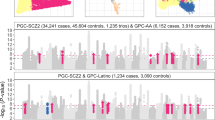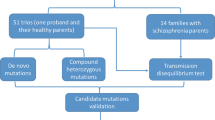Abstract
The gene that codes for dopamine receptor D2 (DRD2 on chromosome 11q23) has long been a prime functional and positional candidate risk gene for schizophrenia. Collectively, prior case–control studies found a reliable effect of the Ser311Cys DRD2 polymorphism (rs1801028) on risk for schizophrenia, but few other polymorphisms in the gene had ever been evaluated and no adequately powered family-based association study has been performed to date. Our objective was to test 21 haplotype-tagging and all three known nonsynonymous single-nucleotide polymorphisms (SNPs) in DRD2 for association with schizophrenia in a family-based study of 2408 Han Chinese, including 1214 affected individuals from 616 families. We did not find a significant effect of rs1801028, but we did find significant evidence for association of schizophrenia with two multi-marker haplotypes spanning blocks of strong linkage disequilibrium (LD) and nine individual SNPs (Ps<0.05). Importantly, two SNPs (rs1079727 and rs2283265) and both multi-marker haplotypes spanning entire LD blocks (including one that contained rs1801028) remained significant after correcting for multiple testing. These results further add to the body of data implicating DRD2 as a schizophrenia risk gene; however, a causal variant(s) in DRD2 remains to be elucidated by further fine mapping of the gene, with particular attention given to the area surrounding the third through fifth exons.
This is a preview of subscription content, access via your institution
Access options
Subscribe to this journal
Receive 12 print issues and online access
$259.00 per year
only $21.58 per issue
Buy this article
- Purchase on Springer Link
- Instant access to full article PDF
Prices may be subject to local taxes which are calculated during checkout

Similar content being viewed by others
References
Itokawa M, Arinami T, Futamura N, Hamaguchi H, Toru M . A structural polymorphism of human dopamine D2 receptor, D2(Ser311 → Cys). Biochem Biophys Res Commun 1993; 196: 1369–1375.
Arinami T, Itokawa M, Enguchi H, Tagaya H, Yano S, Shimizu H et al. Association of dopamine D2 receptor molecular variant with schizophrenia. Lancet 1994; 343: 703–704.
Verga M, Macciardi F, Pedrini S, Cohen S, Smeraldi E . No association of the Ser/Cys311 DRD2 molecular variant with schizophrenia using a classical case control study and the haplotype relative risk. Schizophr Res 1997; 25: 117–121.
Glatt SJ, Faraone SV, Tsuang MT . Meta-analysis identifies an association between the dopamine D2 receptor gene and schizophrenia. Mol Psychiatr 2003; 8: 911–915.
Glatt SJ, Jönsson EG . The Cys allele of the DRD2 Ser311Cys polymorphism has a dominant effect on risk for schizophrenia: evidence from fixed- and random-effects meta-analyses. Am J Med Genet B Neuropsychiatr Genet 2006; 141: 149–154.
Seeman P, Schwarz J, Chen JF, Szechtman H, Perreault M, McKnight GS et al. Psychosis pathways converge via D2 high dopamine receptors. Synapse 2006; 60: 319–346.
Cravchik A, Sibley DR, Gejman PV . Functional analysis of the human D2 dopamine receptor missense variants. J Biol Chem 1996; 271: 26013–26017.
Hwu HG, Faraone SV, Liu CM, Chen WJ, Liu SK, Shieh MH et al. Taiwan schizophrenia linkage study: the field study. Am J Med Genet B Neuropsychiatr Genet 2005; 134: 30–36.
Cloninger CR . Schizophrenia: genetic etiological factors. In: Kaplan HI, Sadock BJ (eds). Comprehensive Textbook of Psychiatry. Williams and Wilkins: Baltimore, 1989.
American Psychiatric Association. Diagnostic and Statistical Manual of Mental Disorders (DSM-IV). American Psychiatric Association: Washington, DC, 1994.
Chen WJ, Faraone SV . Sustained attention deficits as markers of genetic susceptibility to schizophrenia. Am J Med Genet 2000; 97: 52–57.
Nurnberger Jr JI, Blehar MC, Kaufmann CA, York-Cooler C, Simpson SG, Harkavy-Friedman J et al. Diagnostic interview for genetic studies. Rationale, unique features, and training. Arch Gen Psychiatry 1994; 51: 849–859.
NIMH Genetics Initiative. Family Interview for Genetic Studies. National Institute of Mental Health: Rockville, 1992.
Sherry ST, Ward M, Sirotkin K . dbSNP-database for single nucleotide polymorphisms and other classes of minor genetic variation. Genome Res 1999; 9: 677–679.
de Bakker PI, Yelensky R, Pe’er I, Gabriel SB, Daly MJ, Altshuler D . Efficiency and power in genetic association studies. Nat Genet 2005; 37: 1217–1223.
The International HapMap Consortium. The International HapMap Project. Nature 2003; 426: 789–796.
Oeth P, Beaulieu M, Park C, Kosman D, del Mistro G, van den Boom D et al. iPLEX™ assay: increased plexing efficiency and flexibility for MassARRAY system through single base primer extension with mass-modified terminators. In Sequenom Application Note; Sequenom Inc., San Diego, CA, 2005; 1–12.
Beaulieu M, Hong P . Multiplexing the homogeneous MassEXTEND™ assay. In Sequenom Application Note; Sequenom Inc., San Diego, CA, 2004; 1–10.
Salanti G, Amountza G, Ntzani EE, Ioannidis JP . Hardy–Weinberg equilibrium in genetic association studies: an empirical evaluation of reporting, deviations, and power. Eur J Hum Genet 2005; 13: 840–848.
Barrett JC, Fry B, Maller J, Daly MJ . Haploview: analysis and visualization of LD and haplotype maps. Bioinformatics 2005; 21: 263–265.
Gabriel SB, Schaffner SF, Nguyen H, Moore JM, Roy J, Blumenstiel B et al. The structure of haplotype blocks in the human genome. Science 2002; 296: 2225–2229.
Lange C, DeMeo D, Silverman EK, Weiss ST, Laird NM . PBAT: tools for family-based association studies. Am J Hum Genet 2004; 74: 367–369.
Horvath S, Xu X, Laird NM . The family based association test method: strategies for studying general genotype—phenotype associations. Eur J Hum Genet 2001; 9: 301–306.
Horvath S, Xu X, Lake SL, Silverman EK, Weiss ST, Laird NM . Family-based tests for associating haplotypes with general phenotype data: application to asthma genetics. Genet Epidemiol 2004; 26: 61–69.
Laird NM, Horvath S, Xu X . Implementing a unified approach to family-based tests of association. Genet Epidemiol 2000; 19 (Suppl 1): S36–S42.
Lange C, DeMeo DL, Laird NM . Power and design considerations for a general class of family-based association tests: quantitative traits. Am J Hum Genet 2002; 71: 1330–1341.
Whittaker JC, Lewis CM . The effect of family structure on linkage tests using allelic association. Am J Hum Genet 1998; 63: 889–897.
Van Steen K, McQueen MB, Herbert A, Raby B, Lyon H, Demeo DL et al. Genomic screening and replication using the same data set in family-based association testing. Nat Genet 2005; 37: 683–691.
Murphy A, McQueen MB, Su J, Kraft P, Lazarus R, Laird NM et al. Genomic screening in family-based association testing. BMC Genet 2005; 6 (Suppl 1): S115.
Nyholt DR . A simple correction for multiple testing for single-nucleotide polymorphisms in linkage disequilibrium with each other. Am J Hum Genet 2004; 74: 765–769.
Bulayeva KB, Glatt SJ, Bulayev OA, Pavlova TA, Tsuang MT . Genome-wide linkage scan of schizophrenia: a cross-isolate study. Genomics 2007; 89: 167–177.
Gurling HM, Kalsi G, Brynjolfson J, Sigmundsson T, Sherrington R, Mankoo BS et al. Genomewide genetic linkage analysis confirms the presence of susceptibility loci for schizophrenia, on chromosomes 1q32.2, 5q33.2, and 8p21–22 and provides support for linkage to schizophrenia, on chromosomes 11q23.3–24 and 20q12.1–11.23. Am J Hum Genet 2001; 68: 661–673.
Lewis CM, Levinson DF, Wise LH, DeLisi LE, Straub RE, Hovatta I et al. Genome scan meta-analysis of schizophrenia and bipolar disorder, part II: Schizophrenia. Am J Hum Genet 2003; 73: 34–48.
Devlin B, Roeder K . Genomic control for association studies. Biometrics 1999; 55: 997–1004.
Acknowledgements
This work was supported in part by a Young Investigator Award from NARSAD, The Mental Health Research Association (SJG), a research project grant (1R01MH059624) from the United States National Institute of Mental Health (MTT) and grants (90-8825PP and 91,92-9113PP) from the National Health Research Institute of Taiwan and the Genomic Medicine Research Program of Psychiatric Disorders of National Taiwan University Hospital. We thank Allison Brown and Maura Regan at the HPCGG for coordinating and performing the genotyping for this project, Sharon Chandler at UCSD for technical assistance, Frank Middleton at SUNY Upstate Medical University for assistance with detecting pedigree inconsistencies and Mendelian errors and Vural Ozdemir at the University of California, Irvine, for critical reading and editing of the manuscript. We further thank our research and clinical collaborators in the Taiwan Schizophrenia Linkage Study Group, including Chih-Min Liu, Wei J Chen, Ming-Ming Tsuang, Shih-Kai Liu, Ming-Hsien Shieh, Tzung-Jeng Hwang, Wen-Chen Ou-Yang, Chun-Ying Chen, Chwen-Cheng Chen, Jin-Jia Lin, Frank Huang-Chih Chou, Ching-Mo Chueh, Wei-Ming Liu, Mei-Hua Hall, Chiao-Chicy Chen, Jia-Jiu Lo, Jia-Fu Lee, Seng Shen, Yung Feng, Shin-Pin Lin, Shi-Chin Guo, Ming-Cheng Kuo, Liang-Jen Chuo, Chih-Pin Lu, Deng-Yi Chen, Huan-Kwang Ferng, Nan-Ying Chiu, Wen-Kun Chen, Tien-Cheng Lee, Hsin-Pei Tang, Yih-Dar Lee, Wu-Shih Wang, For-Wey Long, Tiao-Lai Huang, Jung-Kwang Wen, Cheng-Sheng Chen, Wen-Hsiang Huang, Shu-Yu Yang and Cheng-Hsing Chen. Finally, we thank the hospitals that participated in this study, including National Taiwan University Hospital and Medical College of National Taiwan University, National Taoyuan Psychiatric Center, National Tsaotun Psychiatric Center, National Cheng-Kung University, Kai-Suan Psychiatric Hospital of Kaohsiung City, Yu-Li Veterans Hospital and National Yu-Li Hospital.
Author information
Authors and Affiliations
Corresponding author
Additional information
Supplementary Information accompanies the paper on the Molecular Psychiatry website (http://www.nature.com/mp)
Supplementary information
Rights and permissions
About this article
Cite this article
Glatt, S., Faraone, S., Lasky-Su, J. et al. Family-based association testing strongly implicates DRD2 as a risk gene for schizophrenia in Han Chinese from Taiwan. Mol Psychiatry 14, 885–893 (2009). https://doi.org/10.1038/mp.2008.30
Received:
Revised:
Accepted:
Published:
Issue Date:
DOI: https://doi.org/10.1038/mp.2008.30
Keywords
This article is cited by
-
The Role of Single Nucleotide Polymorphisms of Monoamine Oxidase B, Dopamine D2 Receptor, and DOPA Decarboxylase Receptors Among Patients Treated for Parkinson’s Disease
Journal of Molecular Neuroscience (2022)
-
A splicing-regulatory polymorphism in DRD2 disrupts ZRANB2 binding, impairs cognitive functioning and increases risk for schizophrenia in six Han Chinese samples
Molecular Psychiatry (2016)
-
The significant association of Taq1A genotypes in DRD2/ANKK1 with smoking cessation in a large-scale meta-analysis of Caucasian populations
Translational Psychiatry (2015)
-
Updated Findings of the Association and Functional Studies of DRD2/ANKK1 Variants with Addictions
Molecular Neurobiology (2015)
-
Stuttering candidate genes DRD2 but not SLC6A3 is associated with developmental dyslexia in Chinese population
Behavioral and Brain Functions (2014)



